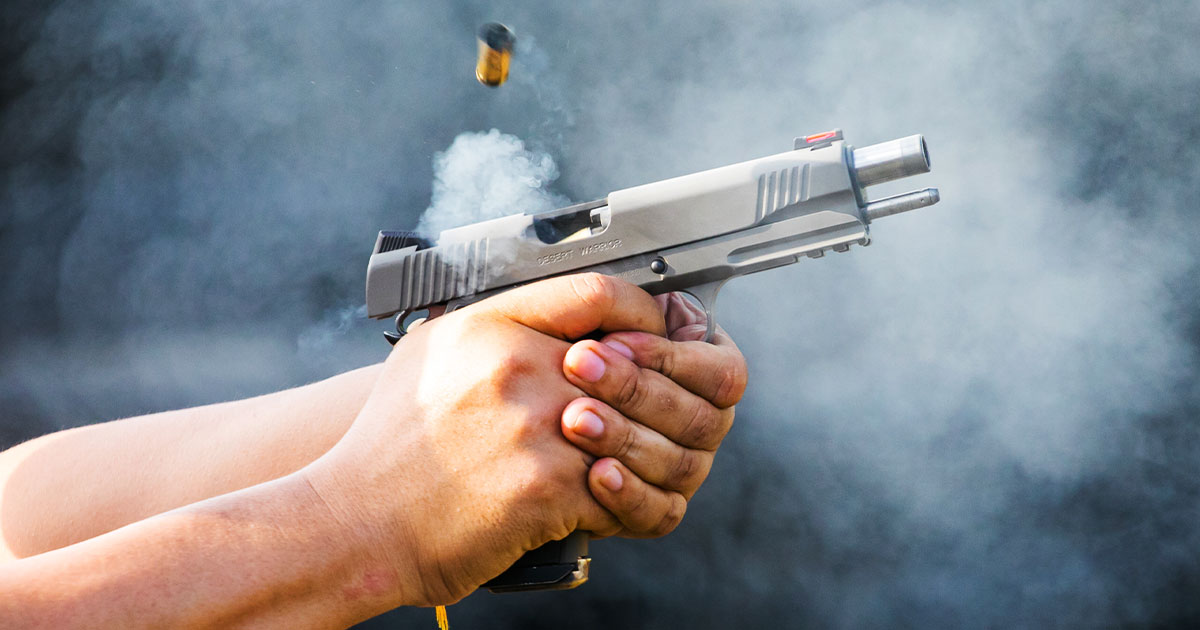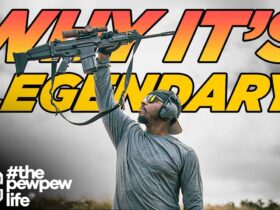Listed To This Article: Play in new window | Download | Embed
You can also subscribe via Apple Podcasts | Spotify | Amazon Music | Android | | More
Nobody wants to kill anyone. Taking a human life is a scary and traumatic thing that has moral and legal ramifications. These concerns may influence someone to fire a warning shot in the hopes it will scare the attacker away without the need to injure or kill another human being. But is firing a warning shot actually effective and a good idea?
The Reasoning Behind Firing a Warning Shot
Movies and TV shows frequently depict police and good guys firing a warning shot, then aiming at their adversary and saying something pithy like, “The next one goes in you.” This gives some people the idea that a warning shot will end the assault without them having to shoot anyone. That is a laudable outlook, but like the old gun culture folk tale that all you have to do is rack the slide on a pump action shotgun and the bad guy will run away, it is not always true. While there are certainly cases where a warning shot has stopped an assault or made the criminal run away, there are many more cases where they did not have the desired effect.
Things to Consider
There are numerous solid reasons why police do not fire warning shots. While it is true that the International Association of Chiefs of Police (IACP) changed its stance on warning shots to endorse them in 2017, they still stated that “warning shots are inherently dangerous.” They go on to say:
“…warning shots must have a defined target and can be considered only when deadly force is justified and when the officer reasonably believes that the warning shot will reduce the possibility that deadly force will have to be used.”
Their position on the topic can be overruled by local law enforcement agencies, and most officers still will not fire a warning shot for several reasons.
Where the Bullet Goes
When I was working in Iraq, it quickly became obvious that the locals loved to shoot their guns in the air. They shot them off for weddings, celebrations, when they were angry, or to intimidate potential opponents. There was constant gunfire in Baghdad, and anywhere else lots of armed locals gathered. As a result, there were a lot of bullets falling out of the sky. I heard them coming down when I was out at night, and we literally had spent bullets lying on the walkways and porches of the fortified villas I sometimes lived in. During my time there, spent bullets went through a truck hood, the roof of someone’s sleeping quarters right over his bed, and hit a client who was walking in the compound at Camp Victory, fortunately only in the top of his buttock.
The fourth rule of safe gun handling states, “Always be sure of your target and beyond.” Essentially, you are responsible for every bullet that leaves the muzzle of your gun, no matter the circumstances. How can you be sure you are shooting in a safe direction, especially if you are in a house or, worse, an apartment complex?
The Time it Takes
You are always reacting in a defensive situation because the bad guy has the initiative. Every shot you fire takes time, maybe not a lot, but it does take time. If your assailant is pointing a gun at you, harming someone else, or charging at you with a knife, shifting off target and firing a warning shot puts you even further behind the power curve than you already are.
Reverse Psychology
Firing a warning shot is intended to scare the attacker away or at least dissuade them from assaulting you out of fear for their own safety. Unfortunately, warning shots can have the opposite effect. For example, if you are not the intended victim of the assault, a warning shot could draw the attacker’s attention to you. Now you are the intended victim, and you are still faced with the decision to shoot or not. Another issue is that the attacker may be on drugs or mentally ill. In both cases, a warning shot may have no effect and may even make them angrier and more homicidal. Warning shots can also escalate the situation by making the bad guy feel threatened enough to pull the trigger on their own gun. Finally, firing a warning shot may make the attacker feel that you will not actually shoot them, encouraging them to continue their assault because they think you are too scared or uncertain to stop them.
Expending a Round
There is a lot of emphasis put on ammunition capacity when selecting an EDC or home defense gun. Some give you as many as 17 or 19 rounds, while others are so compact they may only hold 6 or 7. Derringers, something I do not recommend for self-defense, only hold 2. Firing a warning shot expends one of those rounds, and while you may think you still have plenty left, you have no real idea of how the encounter is going to go, so why take the chance? Some statistics indicate that as many as 47% of defensive encounters involve more than one assailant.
Potential Legal Ramifications
Firing warning shots may have legal consequences you never even thought of. In some localities, a warning shot may be considered as the use of deadly force, even if no one was hit. This is especially problematic if the other guy did not fire a shot. Under those circumstances, you would be the only one to use a firearm, and if you had time to fire a warning shot, a jury might conclude that you were not under threat of imminent death or serious injury when you fired.
Even if you are not charged with the use of deadly force, you could be charged with illegally discharging a firearm. It may sound crazy, but it has happened. You could also face criminal charges and/or a civil action if your warning shot hits an unintended target, such as another person, someone’s vehicle, or something critical like a home or even a gas line. A warning shot may also be used against you in court if you are charged as a result of the encounter, with an anti-self-defense prosecutor using it to portray you as trigger-happy and looking for a fight. Does that sound far-fetched? It, too, has happened.
Chaser Shots
People sometimes fire warning shots when the assailant is running away to scare them enough to keep running and never come back. This has even more problems than firing an initial warning shot. Along with all the issues already discussed, a person running away is no longer a threat, so you have no legal basis for continuing to shoot.
Mindset
The second rule of safe gun handling is, “Never let the muzzle cover anything which you are not willing to destroy.” That being the case, you should not point your gun at a violent assailant unless you are willing to shoot to defend yourself or your family. If you are not, you may want to reconsider carrying a gun. Drawing a gun and holding it carelessly or pointing it at the ground or in the air tells a criminal that you are not committed to using it. On the other hand, drawing a gun and aiming with firm determination is often all that is necessary to induce the bad guy to retreat.
The 2021 National Firearms Survey found that 31.1% of all gun owners who responded to the survey said that they had used their firearm in self-defense at least once. Of those who had used a gun to defend themselves, no shots were fired 81.9% of the time. Of that percentage, displaying a gun caused the attacker to withdraw 50.9% of the time, and simply telling someone they had a gun ended the incident 31% of the time. To put that in perspective, most criminals will flee as soon as they know their intended victim is armed. If the bad guy sticks around even after they know you are armed, it’s a reasonably safe bet that they intend to do you harm. In that case, a warning shot is unlikely to make any difference.
The Bottom Line
The reasons why people fire a warning shot are well-intentioned. In most cases, they do not want to harm anyone, although in a few cases, they may lack the commitment to follow through. However, given the many issues that may arise from firing a warning shot and the fact that most armed defensive encounters end with no shots being fired, warning shots are not a good idea under the vast majority of circumstances. You may have no choice except to draw and fire quickly, and if you do have time for another option, it is better to present a determined attitude that clearly says you are prepared to defend yourself.
Read the full article here







Leave a Reply